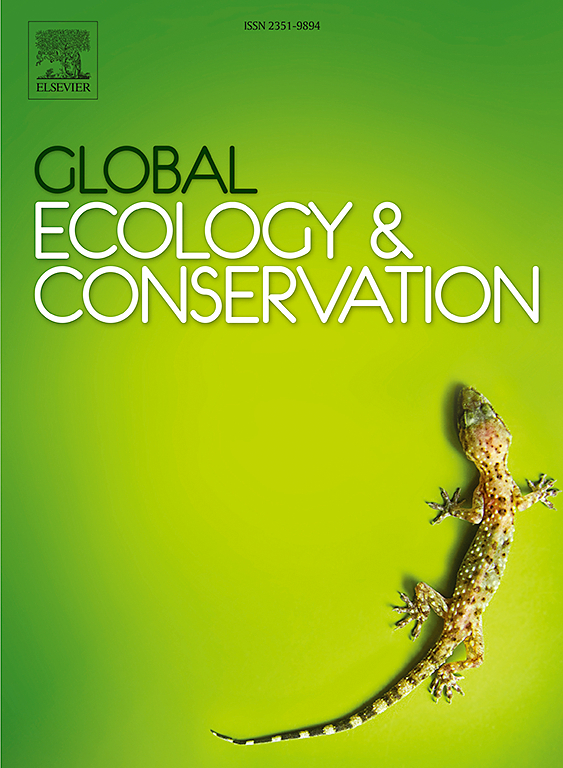基于edna的qPCR和dPCR检测濒危巨倒钩空间分布和相对丰度方法的建立
IF 3.5
2区 环境科学与生态学
Q1 BIODIVERSITY CONSERVATION
引用次数: 0
摘要
巨型倒钩鱼(Catlocarpio siamensis)是鲤科最大的淡水鱼,在包括泰国在内的几个国家都有发现。由于它的体积大,它一直是当地社区的一种受欢迎的食物来源。然而,由于过度捕捞、栖息地破坏和水污染,该物种的数量急剧下降。因此,在世界自然保护联盟的红色名录上,巨型倒钩现在被列为极度濒危物种(CR),有报道称一些河流中已经没有了它。监测巨型倒钩的分布对于制定适当的保护策略至关重要。本研究利用qPCR和dPCR技术建立了环境DNA (eDNA)检测和监测巨倒钩的方法。两种基于eDNA的方法都能成功检测到Giant Barb,其中dPCR更敏感,在31个位点中检测到27个,而qPCR检测到14个位点。qPCR的平均eDNA浓度范围为0.522 ~ 0.716 copies/µl,而dPCR的范围更广,为0.470 ~ 0.871 copies/µl。dPCR在所有7个目测位点检测到鱼的eDNA,而qPCR仅在3个位点检测到。在本研究中,dPCR在获取分布数据方面表现出较好的性能,对濒危鱼类的检测和监测具有重要意义。这种基于edna的保护方法为保护这一重要物种和保护我们的淡水栖息地提供了希望和帮助。本文章由计算机程序翻译,如有差异,请以英文原文为准。
Development of an eDNA-based qPCR and dPCR method for detecting the spatial distribution and relative abundance of the critically endangered Giant Barb (Catlocarpio siamensis)
Giant Barb (Catlocarpio siamensis) is the largest freshwater fish in the Cyprinidae family and is found in several countries, including Thailand. Due to its large size, it has been a popular food source for local communities. However, the population of this species has drastically declined due to overfishing, habitat destruction, and water pollution. Consequently, the Giant Barb is now classified as Critically Endangered (CR) on the IUCN Red List, and there have been reports of its absence from some rivers. Monitoring Giant Barb’s distribution is essential for developing appropriate conservation strategies. Here, we developed environmental DNA (eDNA) assays using qPCR and dPCR for detecting and monitoring the Giant Barb. Both eDNA-based methods were successful in detecting Giant Barb eDNA, with dPCR being more sensitive, detected the Giant Barb at 27 out of 31 sites, whereas qPCR detected it at 14 sites. The average eDNA concentrations for qPCR varied from 0.522 to 0.716 copies/µl, while dPCR had a broader range of 0.470–0.871 copies/µl. dPCR detected fish eDNA at all seven visually confirmed sites, whereas qPCR only detected it at three locations. In the present study, dPCR demonstrated better performance in acquiring distribution data, making it important for detecting and monitoring endangered fish species. This eDNA-based method of conservation offers hope and assistance for protecting this important species and preserving our freshwater habitats.
求助全文
通过发布文献求助,成功后即可免费获取论文全文。
去求助
来源期刊

Global Ecology and Conservation
Agricultural and Biological Sciences-Ecology, Evolution, Behavior and Systematics
CiteScore
8.10
自引率
5.00%
发文量
346
审稿时长
83 days
期刊介绍:
Global Ecology and Conservation is a peer-reviewed, open-access journal covering all sub-disciplines of ecological and conservation science: from theory to practice, from molecules to ecosystems, from regional to global. The fields covered include: organismal, population, community, and ecosystem ecology; physiological, evolutionary, and behavioral ecology; and conservation science.
 求助内容:
求助内容: 应助结果提醒方式:
应助结果提醒方式:


